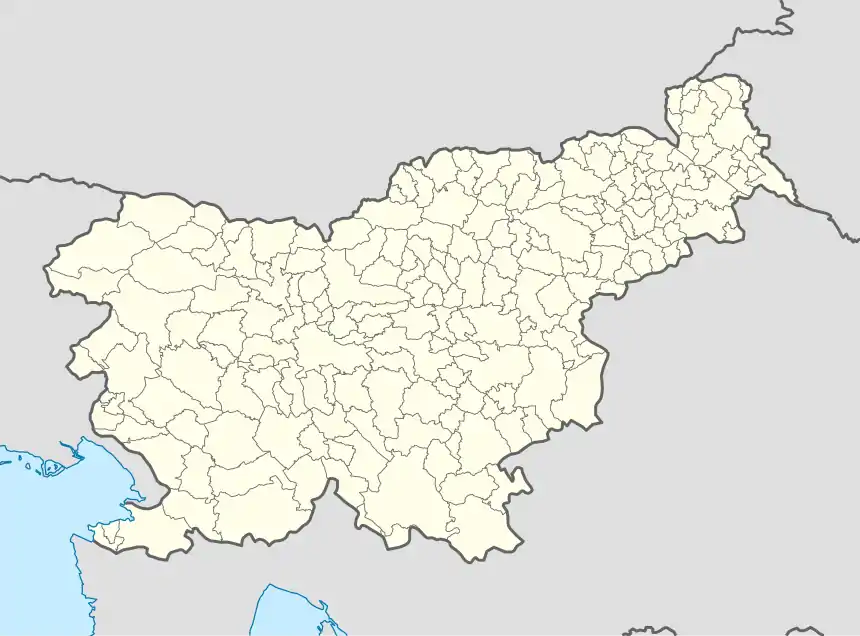Črnuče
Črnuče (pronounced [tʃəɾˈnuːtʃɛ]; German: Tschernutsch[2]) is a former town in the northern part of Ljubljana, the capital of Slovenia. It lies on the left bank of the Sava River. It is part of the traditional region of Upper Carniola and is now included with the rest of the municipality in the Central Slovenia Statistical Region.[3]
Črnuče | |
|---|---|
 Sts. Simon and Jude the Apostle Church | |
 Črnuče Location in Slovenia | |
| Coordinates: 46°6′21″N 14°31′53″E | |
| Country | |
| Traditional region | Upper Carniola |
| Statistical region | Central Slovenia |
| Municipality | Ljubljana |
| Elevation | 298 m (978 ft) |
Name
Črnuče was attested in written sources in 1322 as Zternuͦtss (and as Zernuschcz in 1345, Zernuͤcz in 1362, and Zarnusch in 1439, among other spellings).[4][5] In the past the German name was Tschernutsch.[2] The name is derived from the plural demonym *Čьrnuťane, based on the Slavic personal name *Čьrnutъ, presumably referring to an early inhabitant of the place.[4]
History
The remains of a prehistoric fortification with embankments was discovered at Tabor Hill (370 m), testifying to early settlement of the area. A prehistoric fort has also been identified south of this at Gradišče. At the site of the current bridge across the Sava River there was a Roman bridge supported by 26 piles. It is believed that the Romans' Sava Fluvia station, marked on the Peutinger Map, stood at this site. Firing tranches dating to 1813, used to guard the bridge during the Napoleonic Wars, are still preserved. The lower part of a French gravestone from this time can also be found along a path in the woods to Spodnje Gameljne.[1]
Črnuče annexed the former villages of Gmajna and Podboršt in 1953.[6] Črnuče itself was annexed by the City of Ljubljana in 1979, ending its existence as an independent settlement.[7]
Church
The church in Črnuče is dedicated to Saints Simon and Jude. It was first mentioned in written sources in 1526. The church was remodeled in the Baroque style in 1743. It was elevated to a vicariate in 1764, and to a parish in 1875. The church was damaged in the 1895 Ljubljana earthquake, and a new neo-Romanesque church was built based on plans by the Austrian architect Raimund Jeblinger (1853–1937). The new church was completed in 1897. The church includes a baptismal chapel designed by Jože Plečnik and stations of the cross from the workshop of Leopold Layer (1752–1828). The interior of the church was painted by Anton Jebačin (1850–1927).[1]
Notable people
Notable people that were born or lived in Črnuče include:
- Janez Pečar (born 1924), lawyer and criminologist[1][8]
- Jože Strgar (born 1929), former Ljubljana mayor[9]
- Džoni Novak (born 1969), footballer
References
- Savnik, Roman, ed. 1971. Krajevni leksikon Slovenije, vol. 2. Ljubljana: Državna založba Slovenije, p. 349.
- Leksikon občin kraljestev in dežel zastopanih v državnem zboru, vol. 6: Kranjsko. Vienna: C. Kr. Dvorna in Državna Tiskarna. 1906. p. 106.
- Ljubljana municipal site
- Snoj, Marko (2009). Etimološki slovar slovenskih zemljepisnih imen. Ljubljana: Modrijan. p. 103.
- "Črnuče". Slovenska historična topografija. ZRC SAZU Zgodovinski inštitut Milka Kosa. Retrieved December 1, 2020.
- Spremembe naselij 1948–95. 1996. Database. Ljubljana: Geografski inštitut ZRC SAZU, DZS.
- "Naselje Ljubljana". Krajevna imena. Statistični urad Republike Slovenije. Retrieved December 31, 2020.
- Univerza v Ljubljani: biografije in bibliografije univerzitetnih učiteljev in sodelavcev. Ljubljana: University of Ljubljana. 1969. p. 147.
- Marn, Urša (June 22, 2018). "Vsak vrt je po desetih letih zrel za prenovo". Mladina. Retrieved June 6, 2019.